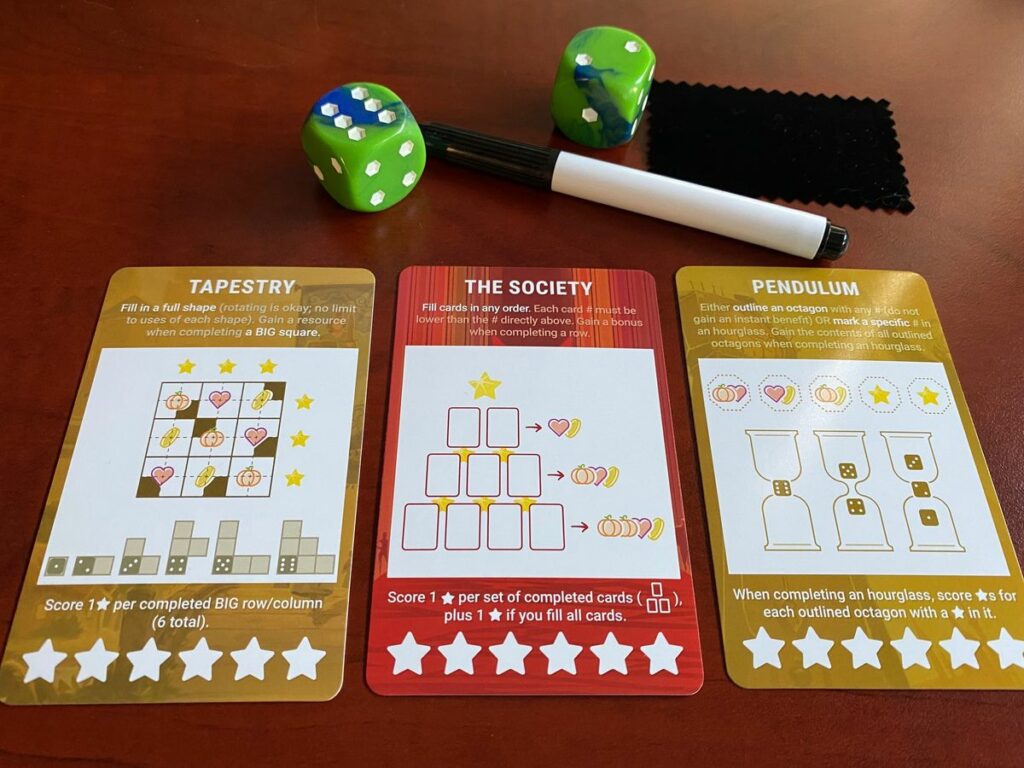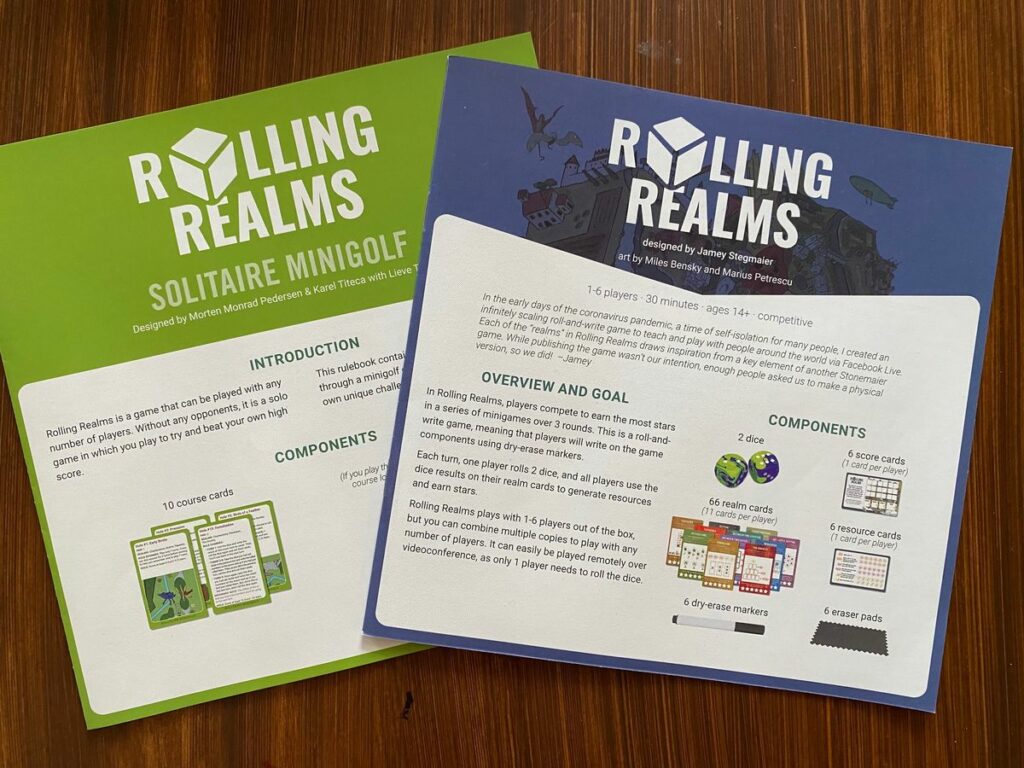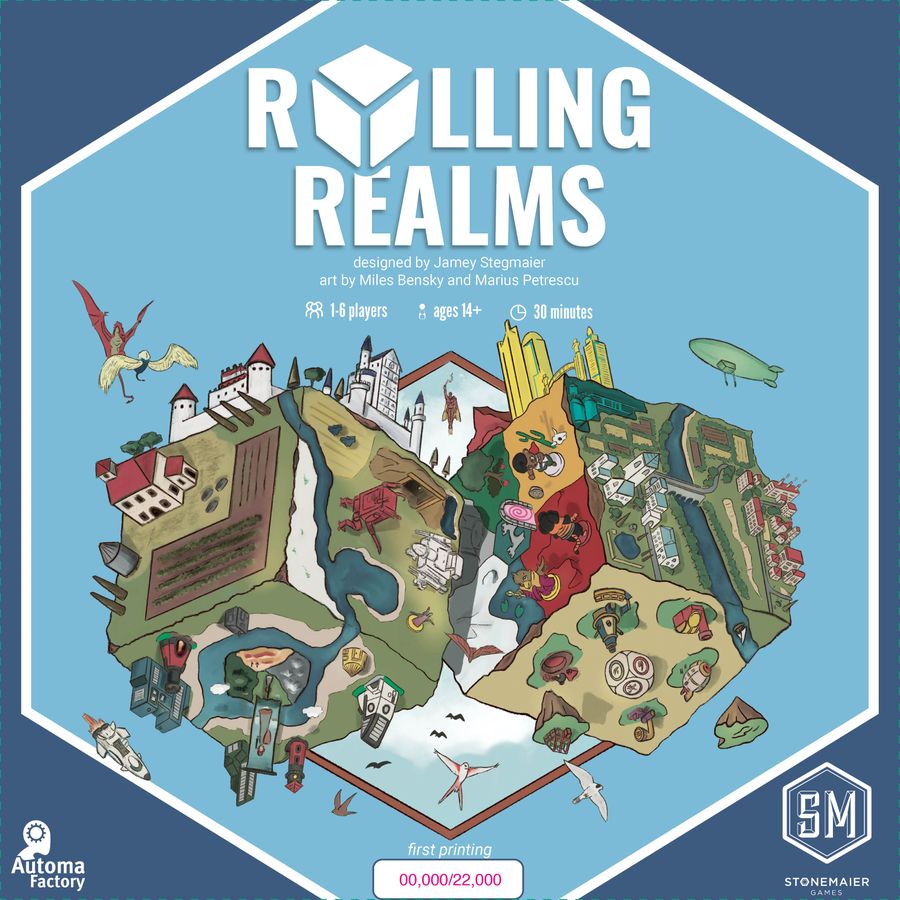Roll-and-write games are bigger now than they’ve ever been. The runaway success of games like Railroad Ink and Ganz Schön Clever paved the way for more ambitious, complex games like Hadrian’s Wall. There are plenty of games out to the gap between those light and heavy titles, and Rolling Realms is one of the latest.
Jamey Stegmaier conceived Rolling Realms during the Covid-19 pandemic, with a view to creating a game for any number of players, which can be played over video calls. Finding inspiration for the setting of a new game isn’t always easy, so Jamey leaned on the Stonemaier back-catalogue to come up with not one, but eleven settings.
Pick n mix
Rolling Realms is essentially a mixture of mini-games. The eleven mini-games are each based on one of Stonemaier’s existing games, so you’ll play something related to Scythe, Viticulture, Wingspan, Euphoria, Tapestry, and more. Each time you play, you’ll randomly choose nine of the eleven game cards. and play over three rounds, with three different cards in each round.

Roll dice, choose things to cross off, get resources and coins, and do stuff with them. The formula is tried and tested, and it works. Rolling Realms carries on in the same vein as something like Hadrian’s Wall or Cartographers, which means you get the same sweet little dopamine kick when combos start firing off, and a crossed box leads to another crossed box, and another, and another… When that feeling gets its hooks into you, it’s extremely satisfying.
As with pretty much every Jamey game, stars are the aim of the game. You get to cross stars off your cards for meeting certain conditions on them, and the skill of the game comes in combining the realms in play to maximise your scoring.
Breeding familiarity
Rolling Realms’ biggest draw is also potentially its biggest drawback too. If you’re familiar with Stonemaier’s games, playing this game is real fan service. It’s a lovely feeling when you’re playing on a realm based on a game you’ve played. I remember the first time I played the Scythe and Euphoria cards, I thought “ooh it’s just like those things in those games!”. It’s like getting a tub of Celebrations chocolates – little bites of things you love.

The problem comes when you don’t know the franchises. Between Two Castles means nothing to someone who doesn’t know the game. Viticulture is wine, sure, but there’s no context. It reminds me of trying to show my nine-year-old the cartoons I loved as a kid. He looks at me out of the corner of his eye saying “Sure dad, these are great…”.
I guess there’s an opportunity to make players familiar with Stonemaier games they’ve not played, but the mechanisms in Rolling Realms are so far removed from their source material that you couldn’t get a feeling for what the originating game is about. On the other hand, it’s a game begging for expansions and promos as more games join Jamey’s stable.
Balance enquiry
Rolling Realms is a perfectly good roll-and-write. The mini-games are god fun and offer up lots of different ways to approach each realm, and work out the best way to combine the ones in play. For a game whose genesis came from a want to create a quick game during lockdown, the balance is surprisingly good. With wildly different combinations of cards you can still expect similar scores whenever you play.

It’s a really easy game to teach, but the first few games can feel a bit stilted. It takes a turn or two to understand how each card works, but luckily the rulebook does a great job of explaining the mechanisms on each. I have no idea what’s going on with the dice, however. They’re gigantic, and a strange blue & green swirly pattern. On the one hand, it makes real sense for a game designed to be playable over a video call or game stream. Bigger = more visible. But the white pips on the different colours makes it hard to tell at first glance sometimes. It’s a small complaint, but it’s something that bothers me every time I open the box.
Final thoughts
Rolling Realms is a great game, and the smallest Stonemaier box I own. It sits in a funny space in my collection, somewhere between filler and main game. There’s a really nice solo version in the box, presented as mini-golf, where each hole is a challenge during play. As much fun as the solo mode is, the multiplayer is where the game comes to life.
It reminds me of playing Cartographers or Tiny Towns more than Ganz Schön Clever. Everyone starts in the same state, plays with the same cards, and uses the results on the same dice. I really like that in a game, there’s no bad luck to blame, it’s just your own choices which influence the outcome. It’s really interesting to see how different strategies play out when each round ends.
If you’re a roll-and-write fan and a fan of Stonemaier games, you really ought to get Rolling Realms. It’s cheaper at <£20 than a lot of the same sort of games which offer far less replayability. It’s still definitely worth buying if you just love this genre of game, just be prepared for the settings on the cards to leave you feeling a bit cold. A game with no theme is fine – Ganz for example – but when a game has a theme and you just don’t get it, it’s an odd experience.
Review copy kindly provided by Stonemaier Games. Thoughts and opinions are my own.

Rolling Realms (2021)
Designer: Jamey Stegmaier
Publisher: Stonemaier Games
Art: Miles Bensky, Marius Petrescu
Players: 1-6 (scalable to any number)
Playing time: 30 mins
